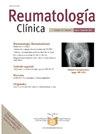纤维肌痛综合征和慢性颈痛患者运动恐惧症和体力活动水平的评估
IF 1.3
Q4 RHEUMATOLOGY
引用次数: 0
摘要
本研究旨在评估纤维肌痛综合征(FMS)和慢性颈部疼痛(CNP)患者和健康对照者的疼痛、运动恐惧症、体力活动、抑郁、疾病严重程度和疲劳。材料与方法将52例FMS患者(1组)、52例CNP患者(2组)和52例健康对照(3组)纳入研究。采用视觉模拟量表(VAS)评估疼痛强度和疲劳程度,采用坦帕运动恐惧量表(TSK)评估运动恐惧程度,采用贝克抑郁量表(BDI)评估抑郁程度,采用国际体育活动问卷(IPAQ)简表评估体育活动水平,采用修正纤维肌痛影响问卷(rFIQ)评估FMS患者的功能状态,采用颈痛残疾指数(NPDI)评估CNP患者的颈痛相关残疾。结果三组患者平均年龄相近(42.96岁),女性比例较高(94.2%,90%,88.6%)。1组患者中有86.6%、2组患者中有63.3%、3组患者中有23.4%存在高水平的运动恐惧症,且1组患者的运动恐惧症发生率高于2组和3组,2组患者的运动恐惧症发生率高于3组。1、2、3组抑郁率分别为80%、50%、16%。在第1组中,70%的患者体力活动水平低,23.3%为中度,6.6%为高。在第2组中,46.6%的患者体力活动水平低,36.6%的患者体力活动水平中等,16.6%的患者体力活动水平高;在第3组中,23.3%的人体力活动水平低,53.4%的人体力活动水平中等,23.3%的人体力活动水平高。三组之间、1组与3组之间的身体活动量差异有统计学意义(p <;0.05),其余配对比较差异无统计学意义(p >;0.05)。1组TSK评分与VAS-pain (p:0.032, r:0.392)、rFIQ评分(p:0.025, r:0.408)呈显著正、弱相关,与BDI评分呈显著正、强相关(p:0.002, r:0.547),与体力活动水平呈显著负、弱相关(p:0.039, r:−0.378)。结论1组和2组患者运动恐惧症、疼痛强度、疲劳程度均高于3组,体力活动水平低于3组。本文章由计算机程序翻译,如有差异,请以英文原文为准。
Evaluation of kinesiophobia and physical activity levels in patients with fibromyalgia syndrome and chronic neck pain
Introduction
We aimed to evaluate pain, kinesiophobia, physical activity, depression, disease severity and fatigue in patients with Fibromyalgia syndrome (FMS) and chronic neck pain (CNP) and healthy controls.
Material and methods
Fifty-two patients with FMS (group 1), 52 patients with CNP (group 2) and 52 healthy controls (group 3) were included in the study. Visual Analog Scale (VAS) was used to evaluate pain intensity and fatigue, Tampa Scale of Kinesiophobia (TSK) for kinesiophobia, Beck Depression Inventory (BDI) for depression, International Physical Activity Questionnaire (IPAQ) Short Form for physical activity level, Revised Fibromyalgia Impact Questionnaire (rFIQ) for functional status in FMS, and Neck Pain Disability Index (NPDI) for neck pain-related disability in patients with CNP.
Results
The mean age was similar in all three groups (42.96) and the ratio of female was higher in all three groups (94.2%, 90%, 88.6%). High level kinesiophobia was present in 86.6% of patients in group 1, 63.3% of patients in group 2 and 23.4% of participants in group 3 and statistically, kinesiophobia was more common in groups 1 than in groups 2 and 3 and in group 2 than in group 3. The rate of depression was 80%, 50% and 16% in groups 1, 2 and 3, respectively. In group 1, 70% of patients had low, 23.3% had moderate, and 6.6% had high physical activity levels. In group 2, 46.6% of patients had low, 36.6% had moderate, and 16.6% had high physical activity levels; in group 3, 23.3% had low, 53.4% had moderate, and 23.3% had high physical activity levels. There was a statistically significant difference in physical activity levels among the three groups and between group 1 and group 3 (p < 0.05), but no statistically significant difference was revealed in the remaining paired comparisons (p > 0.05). TSK score was positively and weakly correlated with VAS-pain (p:0.032, r:0.392) and rFIQ scores (p:0.025, r:0.408) in group 1, positively and strongly correlated with BDI scores (p:0.002, r:0.547) in group 1, and negatively and weakly correlated with physical activity levels (p:0.039, r: −0.378) in group 2.
Conclusions
The patients with group 1 and group 2 had higher levels of kinesiophobia, pain intensity, fatigue and a lower physical activity level than group 3.
求助全文
通过发布文献求助,成功后即可免费获取论文全文。
去求助
来源期刊

Reumatologia Clinica
RHEUMATOLOGY-
CiteScore
2.40
自引率
6.70%
发文量
105
审稿时长
54 days
期刊介绍:
Una gran revista para cubrir eficazmente las necesidades de conocimientos en una patología de etiología, expresividad clínica y tratamiento tan amplios. Además es La Publicación Oficial de la Sociedad Española de Reumatología y del Colegio Mexicano de Reumatología y está incluida en los más prestigiosos índices de referencia en medicina.
 求助内容:
求助内容: 应助结果提醒方式:
应助结果提醒方式:


